
Ken Potter's Educational Series ...


Ken Potter's Educational Series ...

Finding Statehood Quarter
Errors!
A Unique Opportunity
Originally presented in the Dec. 5, 2000 issue of Numismatic
News
Presented here with permission of Krause Publications
Numismatic News
by Ken Potter – NLG
October 22, 2000
All text & photos © Ken Potter 2000
A unique area of opportunity available to collectors of error coins is in the unsearched bags of "Statehood Commemorative quarters" that the United States Mint has been selling direct to collectors since the launch of that program in 1999. Unsearched bags can also be obtained through private dealers. While the vast majority of odd-size or otherwise misshapen errors, get caught by the Mint’s inspection and sorting processes, a few do escape the system into bulk bags of coin. Normally, most of those "escapees" get caught by privately operated coin wrapping operations during the process of rolling the coins into the familiar tubes we see in cash drawers. Those persons, in turn, supply error dealers with most of the new errors that we see offered each year.
The Mint’s decision to sell these quarters in bulk, direct to the collector, means that the valuable error coins that banks and other coin wrapping operations virtually monopolized upon for decades, are now available to you! While, Mint-sewn bags of coin have always been available, collectors often had to know the right person in a bank or have a large enough account to be granted the favor of obtaining a few of these bags. The alternative was to purchase them from dealers at hefty premiums, which in the current market must be viewed as "reasonable" since these bags have been steadily increasing in value. Today, unsearched bags of States quarters can be obtained directly from the Mint for a modest fee plus shipping charges. Each bag represents an opportunity of possibly finding a valuable error coin (or more) that could net you hundreds or even thousands of dollars!
These bags represent a golden opportunity to the collector because the bulk sales program comes at a time when more errors than ever are being produced, (due to high coinage output demands on the Mint), and at a time when State quarter errors are, unquestionably, the most active area in the error coin market. While it might at first seem that increased supplies of errors would be counterproductive to the market, the fact is they represent a significant number of diverse error types - some very rare - that have been well distributed amongst the commemorative designs introduced thus far, (five State quarter designs are being issued each year for ten years). Furthermore, each design represents a one-year-of-type or perhaps what, one observer states, might be better described as a "two-months-of-issue-type," since most of the designs are struck within 30 to 45 production days or "within two-months." This virtually guarantees that almost as quickly as the supply of one Statehood design enters the market, it will end abruptly and the supply of the next issue will begin. Even more importantly, many error collectors collect by type, i.e., one of each of their favorites error types on each denomination and design. Thus what at first seems like a large number will be minuscule when one compares the total mintage on any one of the States Commemorative quarter designs to that of all dates for the regular issue clad-date Washington quarters.
In this chapter, we show some of the States quarter error coins that have been found thus far along with a brief description of how each occurred and an approximate estimate of what it is worth. It needs to be emphasized that values of error coins can range greatly depending on the dealer handling them, and the individual characteristics of the coins. One dealer may place a greater value on a certain error type than another based solely on his/her preferences or a knowledge that he/she has the clientele to support the price attached. Furthermore, while there may be many similar errors within a given type, most errors are one-of-a-kind and prices will be based on each coin’s individual characteristics and eye appeal. The prices quoted here, represent estimates given to us by two of the nations largest error coin dealers, for the specific coins shown.
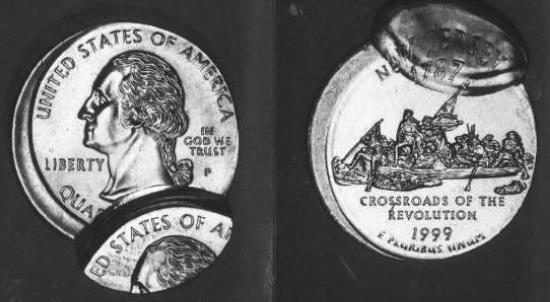
coin courtesy of Fred Weinberg
Our first coin is a 1999-P New Jersey quarter that is Double Struck with both strikes Off-Center. The first strike is off-center by about 15% while the second strike overlaps into the first strike and blank area. The second strike is about 80% off-center and occurred while the coin was resting on top of another blank. This caused the reverse to display a stretched out, distorted image of the original strike in that area or what is referred to in the hobby as "Uniface Reverse." It is valued at approximately $650 to $700.
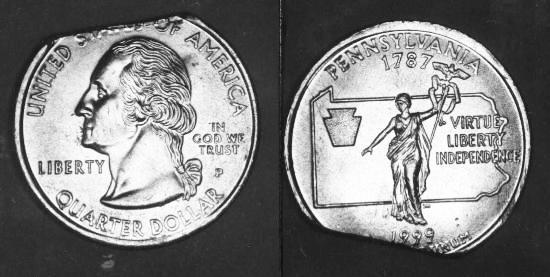
coin courtesy of Fred Weinberg
The 1999-P Pennsylvania quarter displays a nice Straight Clip of about 15% at 11:30 . Straight clips are a form of "Incomplete Planchet" error and occur when the blank is punched out from either side or the end of the coinage strip. (A "planchet" is a blank that has been processed to have it's rim raised slightly and is ready for striking into a coin.) This error is less spectacular than many of the others shown here, but it appears to be quite rare on this series and is a highly sought after type. It is valued at approximately $100.
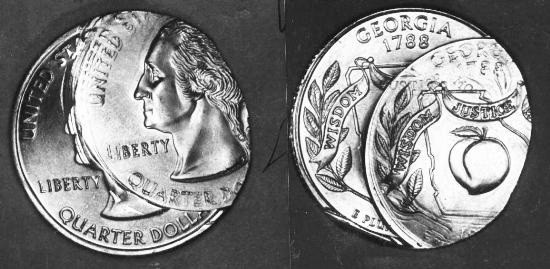
coin courtesy of Fred Weinberg
This spectacular 1999-P Georgia commemorative piece is a dramatic quadruple strike! The first strike was normal while a succession of three closely overlapping, off-center strikes battered the coin before it was finally ejected from the coining chamber. The tripling of the trio of off-center strikes is best viewed on the tops of UNITED. It is worth approximately $850 to $950.
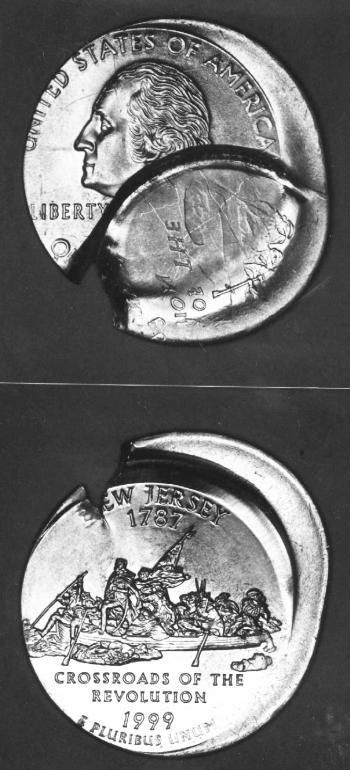
coin courtesy of Fred Weinberg
The 1999-? New Jersey piece shown here was struck off-center by about 20% while another coin was resting partially on top creating a huge indented area with an incuse mirror design of the reverse within. This multiple error coin is known as an Off-Center with Partial Brockage. The extra thickness of metal from both the coin and the planchet being struck together caused the planchet to split adding just a bit more eye appeal to this "mess." This one is worth from about $375 to $550.
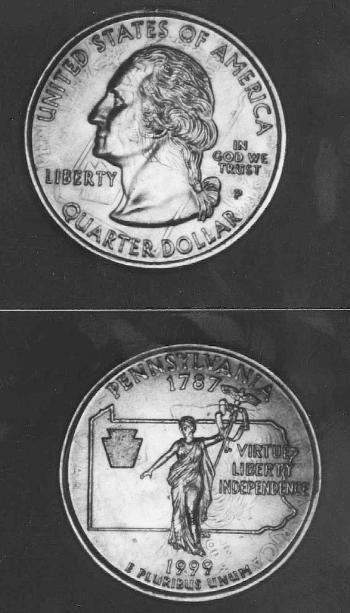
coin courtesy of Ken Potter
The 1999-P Pennsylvania quarter shows the image of both the obverse and reverse on both sides. The ghostly image below the strong image is the result of this coin having been struck once and then flipping over and reentering the coining press for a second on-center strike. This one is referred to as Double Struck Flipover In Collar and is valued at about $700.
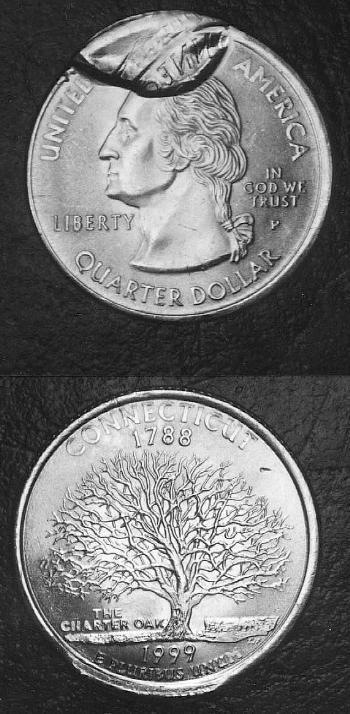
coin courtesy of Fred Weinberg
Here is a 1999-P Connecticut quarter that was partially indented by another struck coin, (apparently another error coin), that fell part way into the dies during the strike. This is known as a Partial Brockage and worth from about $190 to $250.
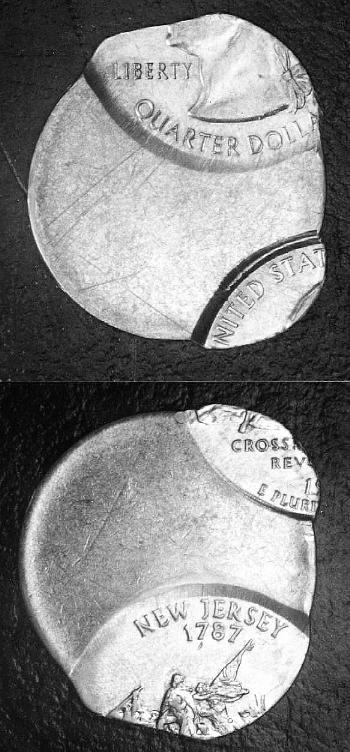
coin courtesy of Fred Weinberg
Next we show a 1999-? New Jersey quarter that was Double Struck with Both Strikes Off-Center. The larger of the two strikes exhibits an area with a flat edge known as a "Chain Edge," a reference alluding to the "linking" of this coin to another. This occurs when two non-overlapping planchets enter partially into the coining chamber in an off center position and are struck simultaneously. Under the pressure of the strike, the metal from both planchets begins to flow in all directions including toward each other. When the metal flowing from both planchets meets, resistance is created and the flow of metal is redirected resulting in the chain edge effect seen on a small percentage of off centers and double strikes. This one is worth from about $550 to $650 "as is" but would be worth about $850 if it was scratch-free.
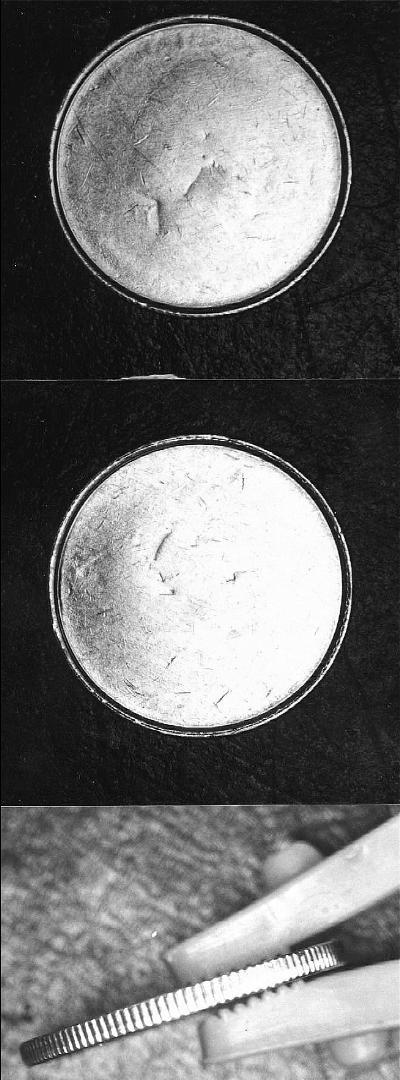
coin courtesy of Fred Weinberg
Here we show yet another 1999-? New Jersey quarter. This one was struck with Filled Dies. In this case the dies were clogged with grease or other contaminants thus preventing the dies from imparting complete designs to the blank. This error type is easily confused with a Weak Strike but an examination of the edge of the coin shows that it has fully struck reeding that could have occurred only if the coin was struck with normal pressure. This one is valued from $40 to $300.
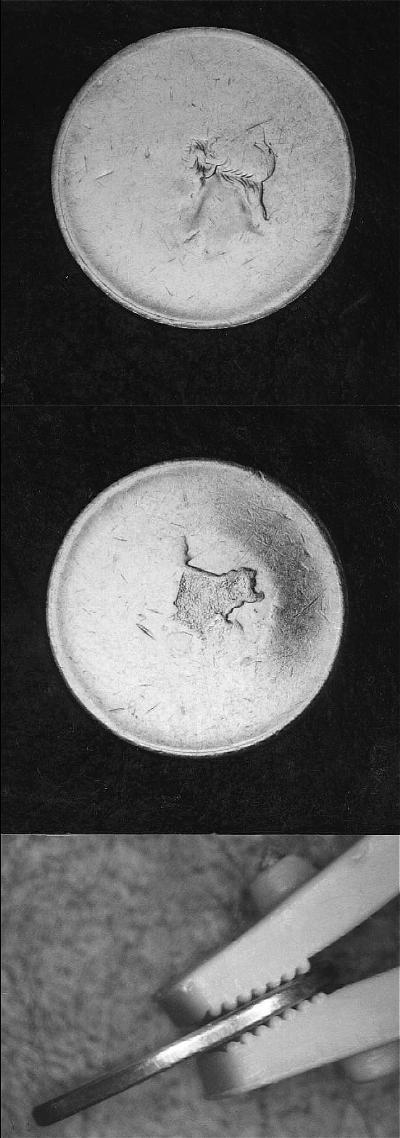
coin courtesy of Fred Weinberg
To illustrate this point further, our next coin is a Weak Strike on a (2000)-? Massachusetts quarter. Notice that not only is the area of design detail on the obverse (Washington side) and reverse extremely weak but the reeding on the edge is non-existent. This one is worth about $400 to $450.
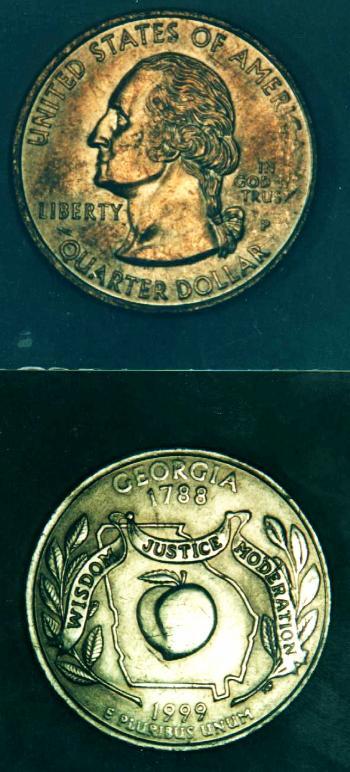
coin courtesy of Ken Potter
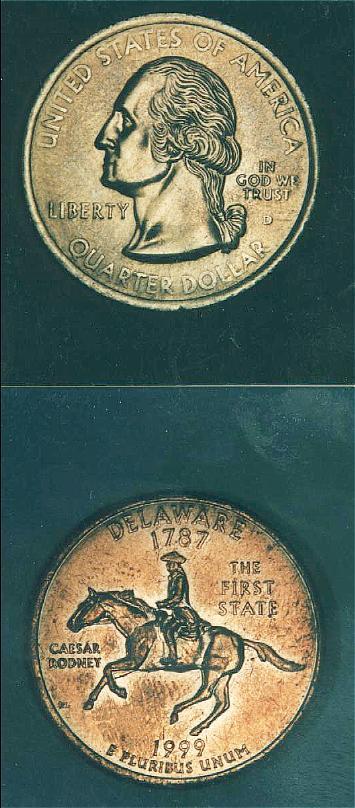
coin courtesy of Chuck Avery
An odd-ball that has been appearing in increasing frequency is the "Clad Layer Missing Before Strike" error. It is represented by the 1999-P Georgia and 1999-D Delaware quarters with a "copper obverse" and "copper reverse," respectively. This error occurs when a blank sheds one of its outer copper-nickel "clad" layers before it is struck. When struck, the side missing the outer layer will be copper while the flip side will be of the normal copper-nickel (silvery) appearance. A clad layer may split off if it is improperly bonded due to contaminants or oxides being trapped between the layers during the bonding process. This error type is worth about $250 to $300 in uncirculated condition. Many of these have been reported on all the State designs as being found in circulation or fresh out of new rolls. They are worth less if circulated. (Note: The yellowish cast seen on the obverse of the Georgia quarter and the reverse of the Delaware quarter are due to the scanning process. They are actually of the normal clad "silvery" appearance.)
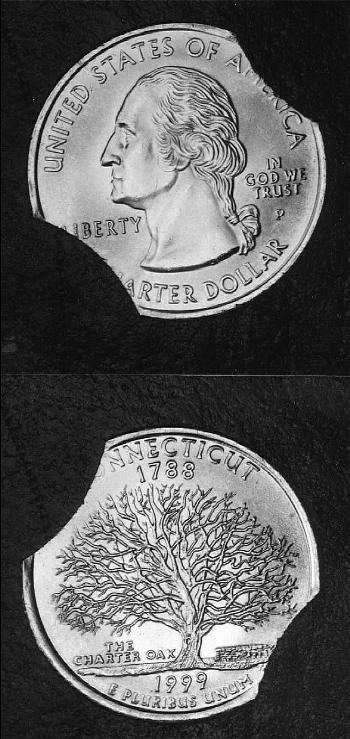
coin courtesy of Fred Weinberg
This 1999-P Connecticut quarter displays two large curved clips. The The term "clip" is a misnomer that errorists tend to accept in describing a general class of planchet error that originates with a blank that was produced with an incomplete area of metal at its edge. The curved clip occurs when a blank is punched from out of an area of strip that overlaps a hole (or holes) from where a blank was previously punched out.
Envision using a cookie cutter to "punch" out a cookie from an area of the rolled out dough that overlaps into an area from where cookies were previously cut out. In this case the blank was punched out from are area overlapping two holes. It is valued at about $125.
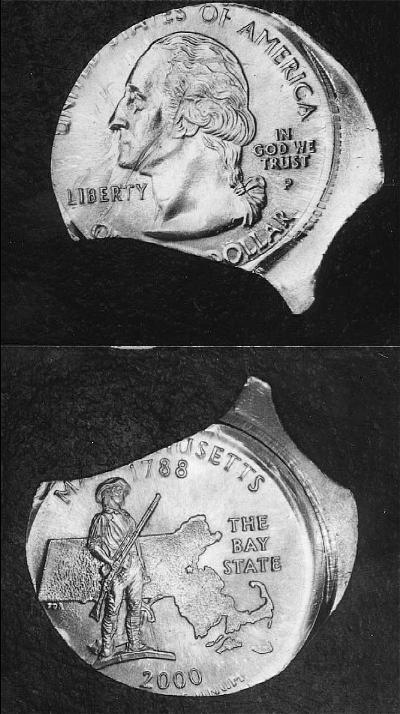
coin courtesy of Fred Weinberg
Our next coin is a 2000-D Massachusetts quarter that was struck Off-Center on a blank with Double Curved Clips. In this case, the clips probably caused the blank to misfeed, causing this spectacular multiple error type. It is valued at approximately $350 but would be worth over $500 if scratch free.

coin courtesy of Fred Weinberg
This 1999-D New Jersey quarter exhibits a "Corner Clip" or what some refer to as an "Assay Clip." This is the result of a piece of metal being snipped from the coinage strip, (in the proximity of where the blank was later punched), for testing. The test may be for assay or to check metal hardness or ductility. This is an extremely rare error type with this one boasting a value ranging from about $400 to $650. This error type is so rare it is difficult to price.
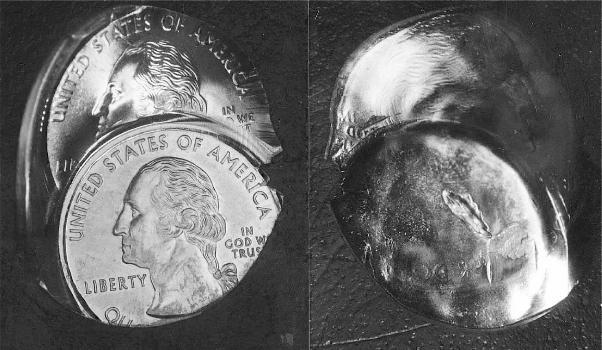
coin courtesy of Fred Weinberg
This States quarter is Double Struck with a Brockaged reverse. The brockage is from the obverse of another coin being impressed into this coin during the strike. This prevents us from determining which of the State’s quarter designs it represents. The date and Mint mark are also unknown due to the orientation of the strikes. Still, the error is so dramatic that it would fetch anywhere from about $550 to $850 in the open market.
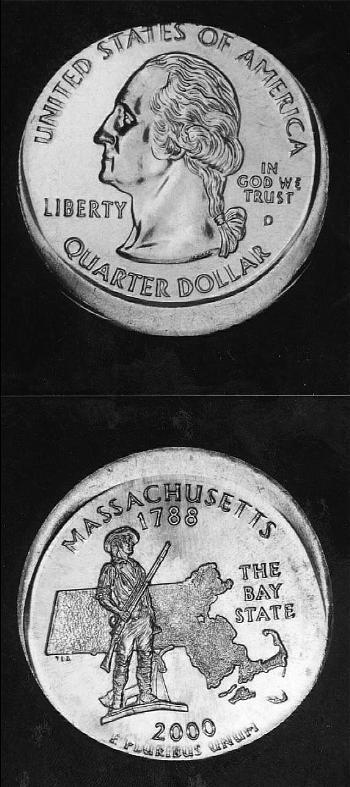
coin courtesy of Fred Weinberg
This 2000-D Massachusetts quarter was struck Off-center by about 10% to 12%. An off-center strike occurs when a planchet fails to enter the striking chamber in a centered position. While it is not as major as some of the other striking errors featured here, it is still a very desirable coin with an affordable value of about $125 to $200.
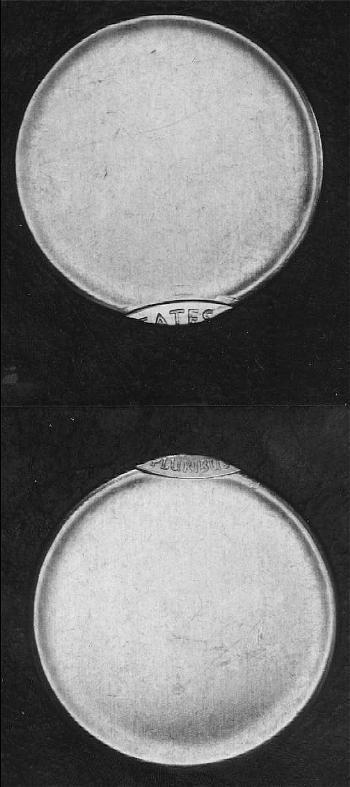
coin courtesy of Fred Weinberg
In sharp contrast to our 10% off-center featured previously, this States quarter of unknown date and type, was struck about 95% Off-Center. Even though, dated pieces struck in the 40% to 60% range are the most desirable to collectors, this one would still command a respectable $100 to $150 if sold to a collector. It would be worth $200 plus if the State could be determined.
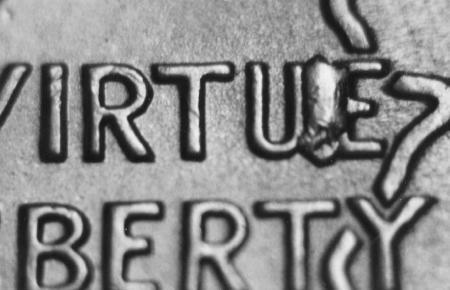
coin courtesy of Frank LaBosco

coin courtesy of Jack Martin
So far everything we’ve looked at has involved an error in the striking of the coin or preparation of the blank. However, errors and varieties can occur to the dies. While recent innovations within the Mint have largely eliminated the possibility of the popular Doubled Dies and Repunched Mint Mark varieties from occurring, minor die variations, (often erroneously referred to as "minor errors)," such as die chips and/or die breaks, die cracks, missing designs due to die-wear and/or abrasion, doubling due to die-deterioration, etc., still occur and are considered collectable by some segments of the hobby. Shown here is a 1999-P Pennsylvania quarter with a large die break between the U and E of VIRTUE. It was found by Frank LaBosco in March of 1999. Also shown is a 1999-P Delaware quarter with die breaks between the A and R of CAESAR and within the lower N of RODNEY. It was found by Jack Martin in March of 1999. Items like those shown have been selling for about $2 while die cracks, missing designs, die deterioration doubling, etc., normally sell for considerably less (depending on the State involved).
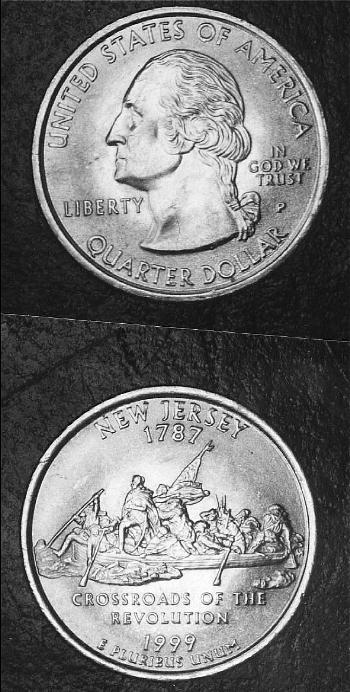
Last but not least are the "Rotated Die Errors." This error type involves the instillation of one of the dies into a press in the wrong rotational allignment, or for one of the dies to break loose from its fixed position, allowing it to rotate within the die holder. Normally, the dies for United States coins will be set into the press with their designs opposite each other; shifted toward opposite poles. This will result in a struck coin that will show the obverse right side up while the reverse is up-side-down. This is normal and referred to as "coin alignment." However, on rare occasions, one of the dies is set so that it strikes coins in an orientation other than "coin alignment." This can result in a coin that if held with its obverse upright, will display the reverse at any alignment other than the proper 180o "coin alignment." The most desirable error of this type is one that shows a 180o misalignment, which of course results in a coin with no rotational differentiation between the obverse and reverse (or what is referred to as "medal alignment" since most commemorative medals, military medals, and tokens are struck in this manner).
To date, at least five different of the States quarter designs have been found with significant "Rotated Die" errors. Any rotational misalignment of over 15% is considered significant.
The values of rotated die errors are partially based on the severity of rotation and rarity. Average prices for 45 degree to 180 degree rotations range widely from from dealer to dealer at about $45 to $450.
There are many more error and variety types that we are unable to elaborate upon within the scope of this article. However, if this article has wet your appetite for errors and you’d like to learn more about them and the clubs and books dedicated to their study, please visit Ken Potter's Variety Vault. You will find pages of error coin listings, (including many with elaborate descriptions and images), books for sale and an Educational Image Gallery with links to more articles like this, and links to the error-variety clubs.
Persons interested in getting on the U.S. Mint’s mailing list to purchase Mint-sewn bags (or other Mint products) may call: 1-800-USA-MINT or log onto the internet at: www.usmint.gov.
Estimated values of coins given here are through the courtesy of Fred Weinberg of Encino, California (fredweinberg1@aol.com) and Rich Schemmer of Franklin Square, New York (richerrors@aol.com).
Recommended reading: The Error Coin Encyclopedia III by Arnold Margolis and Fred Weinberg. This new book contains a special section on Statehood quarter errors. Order your copy here: ECE
Watch for the next installment of this series in Numismatic News.
Click here: Numismatic News to learn how to subscribe to Numismatic News or learn more about Krause Publications.
Ken Potter is the official attributer and lister of world doubled dies for the Combined Organizations of Numismatic Error Collectors of America and for the National Collectors Association of Die Doubling. He privately lists U.S. doubled dies and other collectable variety types on both U.S. and world coins in the Variety Coin Register. For more information on either of the clubs, or on how to get a variety listed in the Variety Coin Register, send a self addressed stamped long envelope to Ken Potter, P.O. Box 33, Pinckney, MI 48169 or log on to his website and go to the "Favorite Places" or the "How to Get A Variety Listed" page. He may be contacted via e-mail at: KPotter256@aol.com. An Educational Image Gallery with links to more educational articles and the error clubs may be accessed on his website at: Ken Potter's Variety Vault

Ken Potter
P.O. Box 33
Pinckney, MI 48169
Phone: 1-(313)268-3280 E-mail: KPotter256@aol.com
Visit our website clicking below:
Ken Potter's Variety Vault
###